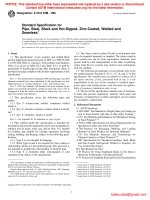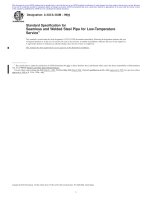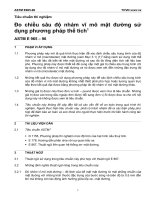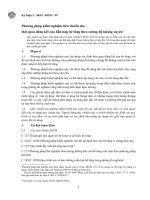Astm e 2038 99 (2004)
Bạn đang xem bản rút gọn của tài liệu. Xem và tải ngay bản đầy đủ của tài liệu tại đây (44.28 KB, 4 trang )
Designation: E 2038 – 99 (Reapproved 2004)
Standard Test Method for
Temperature Calibration of Dielectric Analyzers1
This standard is issued under the fixed designation E 2038; the number immediately following the designation indicates the year of
original adoption or, in the case of revision, the year of last revision. A number in parentheses indicates the year of last reapproval. A
superscript epsilon (e) indicates an editorial change since the last revision or reapproval.
equation, for one or more transitions, the temperature scale or
readout of the apparatus is calibrated based upon the known
and observed transition temperatures.
1. Scope
1.1 This test method describes the temperature calibration
of dielectric analyzers over the temperature range from –100 to
300 °C and is applicable to commercial and custom-built
apparatus. The calibration is performed by observing the
melting transition of standard reference materials having
known transition temperatures within the temperature range of
use.
1.2 Electronic instrumentation or automated data analysis
and data reductions systems or treatment equivalent to this test
method may be used.
1.3 The values stated in SI units are to be reported as the
standard.
1.4 This standard does not purport to address all of the
safety concerns, if any, associated with its use. It is the
responsibility of the user of this standard to establish appropriate safety and health practices and to determine the
applicability of regulatory limitations prior to use.
5. Significance and Use
5.1 This test method permits interlaboratory comparison
and intralaboratory correlation of instrumental temperature
scale data.
5.2 Dielectric analyzers are used to characterize a broad
range of materials that possess dielectric moments. One of the
desired values to be assigned by the measurement is the
temperature at which significant changes occur in the properties of the test specimen. In order to obtain consistent results
from one period of time to another and from one laboratory to
another, the temperature signal from the apparatus must be
calibrated accurately over the temperature range of interest.
6. Interferences
6.1 Because the specimen size usually is small, care must be
taken to ensure that each specimen is homogeneous and
representative of the sample as a whole.
6.2 This test method measures dielectric properties under
specific experimental conditions. Should those experimental
conditions change, there may be an effect on the calibration of
the apparatus.
6.3 Contact or adhesion of the specimen to the sensor
should not be lost during the course of the measurement,
otherwise erroneous values will be recorded.
2. Referenced Documents
2.1 ASTM Standards: 2
E 473 Terminology Relating to Thermal Analysis
E 1142 Terminology Relating to Thermophysical Properties
3. Terminology
3.1 Definitions—Specific technical terms used in this test
method are defined in accordance with Terminologies E 473
and E 1142.
7. Apparatus
7.1 Dielectric Analyzer, consisting of the following items:
7.1.1 Sensors, electrodes for imparting the alternating electric field and measuring the induced current and phasing in the
specimen. These usually are solid platforms that also serve to
hold the specimen. These may be either two parallel plate
electrodes or a single plate containing a series of interdigitated
electrodes.
4. Summary of Test Method
4.1 A test specimen of known solid-solid or solid-liquid
(melting) transition temperature is characterized for its dielectric properties in a dielectric analyzer of interest as a function
of temperature. At the transition, a sharp change in the
dielectric properties is observed. The temperature observed for
the transition by the apparatus is recorded. Using a linear
NOTE 1—When using parallel plate electrodes, provision shall be made
to prevent the electrodes from contacting each other upon the melting of
the test specimen.
1
This test method is under the jurisdiction of ASTM Committee E37 on Thermal
Measurements and is the direct responsibility of Subcommittee E37.01 on Test
Methods and Recommended Practices.
Current edition approved Sept. 10, 1999. Published November 1999.
2
For referenced ASTM standards, visit the ASTM website, www.astm.org, or
contact ASTM Customer Service at For Annual Book of ASTM
Standardsvolume information, refer to the standard’s Document Summary page on
the ASTM website.
7.1.2 Temperature Sensor, for measuring the specimen temperature to within 6 0.1 °C.
Copyright © ASTM International, 100 Barr Harbor Drive, PO Box C700, West Conshohocken, PA 19428-2959, United States.
1
E 2038 – 99 (2004)
10. Sampling
10.1 Samples usually are analyzed on an “as received”
basis. If some thermal or mechanical treatment, such as
grinding or sieving, is applied to the sample prior to analysis,
it shall be indicated in the report.
10.2 Since small test specimens are used, they must be
homogeneous and representative of the sample. The mixing or
stirring of samples prior to analysis is recommended.
10.3 The test specimen must cover the entire surface of
parallel plate electrodes. The test specimen thickness depends
on the dielectric properties of the specimen and the sensor size;
however, a minimum thickness of 0.10 mm is recommended.
10.4 For interdigitated electrodes the test specimen should
cover the electrode array completely. The thickness of the test
specimen should be at least 1.5 times the electrode spacing.
7.1.3 Specimen Container, for containing the test specimen
in liquid form (after it melts).
7.1.4 Temperature Programmer and Furnace, capable of
temperature programming the test specimen from –100 to
300 °C at a rate of at least 1°C/min, or performing isothermal
temperature operation at temperatures over the range of interest
to 6 1 °C.
7.1.5 Cooling Device and Supplies, to provide operating
temperatures below ambient temperatures. This may be a
mechanical refrigerator or other coolant such as liquid nitrogen.
7.1.6 Specimen Atmosphere Control System, capable of
supplying inert gas, usually nitrogen, argon, or helium, with an
operator selectable flow rate of 50 to 100 mL/min to within 6
5 mL/min.
7.1.7 Recording Device, either digital or analog, to record
and display the dielectric thermal curve consisting of permittivity on the Y axis (ordinate) and temperature on the X axis
(abscissa).
7.1.8 While not required, it is convenient to have a data
analysis device that will perform and display the calculations
of this test method.
11. Calibration and Standardization
11.1 Calibrate the permittivity and temperature sensors of
the apparatus using the procedure described by the manufacturer in the operator’s manual.
11.2 Calibration materials with a dielectric moment and
with a solid-solid or solid-liquid (melting) transition of known
value may be used. The 99.9+ % pure materials listed in Table
1 may be used for calibration.
8. Reagents and Materials
8.1 Inert Gas, purified, dry nitrogen, argon, or helium.
12. Procedure
12.1 Select two calibration materials (see Table 1) that have
transitions near the extremes of the temperature range of
interest.
12.2 Load the calibration material with the lower transition
temperature into the apparatus as a test specimen.
12.3 Set the initial temperature of the apparatus to a value
about 30 °C below the estimated transition temperature of the
calibration material.
12.4 Initiate the measurement of permittivity at a test
frequency of 1000 Hz. Initiate a temperature program of
constant heating rate of 1 to 3 °C/min to a temperature 20 °C
above the estimated transition temperature of the calibration
materials. Record permittivity, on a linear scale, as a function
of temperature.
NOTE 2—If calibration is to be done at low temperatures, that is, below
the dew point, it is essential to have a dry environment as condensed
moisture can affect the results.
8.2 Calibration Materials, two materials possessing dielectric properties that undergo a solid-liquid (melting) or solidsolid transition within the temperature range of interest. Several suitable materials are listed in Table 1.
9. Hazards
9.1 Toxic or corrosive effluents, or both, may be released
when heating some materials and could be harmful to personnel and to apparatus.
9.2 High voltages may exist on the exposed electrodes
during the procedure. Care should be taken to avoid contact
with the electrodes.
9.3 Some components of the test circuit, including the
sample itself, may retain electrical charge even after the test is
completed and the voltage source is disconnected. Ensure that
all charges are eliminated from these components before
touching the instrument.
NOTE 3—Other test frequencies may be used but shall be indicated in
the report.
NOTE 4—Other heating rates may be used but shall be indicated in the
report.
12.5 Remove residue reference material and clean the electrodes at the end of the experiment.
NOTE 5—Cleaning of the electrodes may be accomplished by washing
with a suitable dissolving solvent, then drying. Alternatively, the electrodes may be heated to a temperature sufficiently high to evaporate any
organic materials remaining provided this temperature does not exceed the
temperature limit of the electrode.
TABLE 1 Calibration MaterialsA
Calibration Materials
1,2-dichloroethane
benzil
acetanalide
benzoic acid
diphenylacetic acid
anisic acid
carbazole
Transition Temperature (°C)
–35.7
94.9
114.4
122.4
147.3
183.3
245.6
(solid - liquid)
(solid - liquid)
(solid - liquid)
12.6 Determine the observed temperature as the extrapolated onset of the increase in permittivity occurring at the
transition (see Fig. 1).
12.6.1 On a linear display of permittivity versus temperature, construct a tangent to the baseline prior to the transition.
12.6.2 Construct a tangent to the permittivity curve at the
steepest portion of the curve following the transition.
(solid - liquid)
(solid - liquid)
A
Available from the Laboratory of the Government Chemist, Queens Road,
Teddington, Middlesex, United Kingdom TW11 0LW.
2
E 2038 – 99 (2004)
Sample: Benzoic acid evaporate and rerun
Size: 0.8000 mm
Method: 3 °C/min, cool, reheat
Comment: N2 purge = 500 mL/min. Look for signal with minimum sample.
FIG. 1
12.6.3 The temperature value at the intersections of the
tangents from 12.6.1 and 12.6.2 is taken as the observed
temperature (TO1).
12.7 Repeat 12.2-12.6 for the calibration material with the
higher transition temperature. The observed value is taken to
be TO2.
such conditions, calibration temperatures sufficiently close together shall
be used so that the instrument calibration is achieved with a series of linear
relations.
13.2 Two-Point Calibration:
13.2.1 Using the standard temperature (TS1 and TS2) values
taken from Table 1 and the corresponding observed temperatures (TO1 and TO2), taken from the experimental section
above, calculate the slope (S) and intercept (I) using Eq 2 and
3.
13. Calculation
13.1 For the purposes of this test method, it is assumed that
the relationship between observed temperature (TO) and the
actual specimen temperature (T) is a linear one governed by Eq
1.
T 5 ~TO 3 S! 1 I
(1)
where:
S and I = the slope and intercept, respectively.
S 5 ~TS1 – TS2! / ~TO1 – TO2!
(2)
I 5 [~TO1 3 TS2! – ~TS1 3 TO2!# / ~TO1 – TO2!
(3)
where:
S
= Slope (nominal value = 1.0000),
I
= Intercept,
NOTE 6—For some instruments, the assumption of a linear relations
between observed and actual specimen temperature may not hold. Under
3
E 2038 – 99 (2004)
TS1
TS2
TO1
TO2
= Reference transition temperature
from Table 1,
= Reference transition temperature
from Table 1,
= Observed transition temperature
determined in 12.6, and
= Observed transition temperature
determined in 12.7.
14.1.1 Complete identification and description of the standard reference materials used for calibration, including source
and purity.
14.1.2 Model number and description of the instrument
used for calibration, including location of the temperature
sensor.
14.1.3 Details of the procedure used for calibration, including a description of the type of sensors, sample container, and
any departures from the described procedure.
14.1.4 Identification of gas composition, flow rate, and
purity of the specimen atmosphere.
14.1.5 Heating rate and exitation frequency used.
14.1.6 A copy of relevant original records.
14.1.7 The values of S and I.
for Standard 1
for Standard 2
for Standard 1
for Standard 2
NOTE 7—I has the same units (that is °C or K) as TS1, TS2, TO1 and
TO2, which are consistent with each other. The value for I will be different,
depending on the units used. S is a dimensionless number whose value is
independent of the units of I or T.
13.2.2 When performing these calculations, retain all available decimal places in the measured values and in intermediate
values of the calculation, such as the values for S and I. The
final calculated or corrected temperature should be rounded to
the decimal place equivalent to two significant places in the
standard deviation. If this temperature is to be used in
subsequent calculations, however, all available decimal places
should be retained.
13.3 One-Point Calibration—If the slope value determined
in 13.2.1 is sufficiently close to 1.0000, only the intercept need
be determined through a subsequent one-point calibration
procedure.
I 5 TS1 – TO1
15. Precision and Bias
15.1 The precision and bias of this test method have not yet
been determined. An interlaboratory test program is planned to
provide such information. Anyone wishing to participate in
such a test program should contact the E37.01 Subcommittee
Chairman in care of ASTM, 100 Barr Harbor Drive, West
Conshohocken, PA 19428–2959.
15.2 A preliminary study3 indicates that the pooled standard
deviation of triplicate determinations of TO on seven materials
is 6 0.70°C with an average bias (TS – TO) of 2.4°C.
(4)
16. Keywords
16.1 calibration; dielectric analyzers (DEA); melting; temperature; thermal analysis
13.4 Using the determined values or S and I, Eq 1 may be
used to calculate the actual specimen transition temperature (T)
from an observed transition temperature (TO).
3
Foreman, J.A., Lundgren, C.J., and Blaine, R.L., “Temperature Calibration of
Dielectric Analyzers,” Proceedings of the 23rd North American Thermal Analysis
Society Conference, 1994, pp. 444–448.
14. Report
14.1 Report the following information:
ASTM International takes no position respecting the validity of any patent rights asserted in connection with any item mentioned
in this standard. Users of this standard are expressly advised that determination of the validity of any such patent rights, and the risk
of infringement of such rights, are entirely their own responsibility.
This standard is subject to revision at any time by the responsible technical committee and must be reviewed every five years and
if not revised, either reapproved or withdrawn. Your comments are invited either for revision of this standard or for additional standards
and should be addressed to ASTM International Headquarters. Your comments will receive careful consideration at a meeting of the
responsible technical committee, which you may attend. If you feel that your comments have not received a fair hearing you should
make your views known to the ASTM Committee on Standards, at the address shown below.
This standard is copyrighted by ASTM International, 100 Barr Harbor Drive, PO Box C700, West Conshohocken, PA 19428-2959,
United States. Individual reprints (single or multiple copies) of this standard may be obtained by contacting ASTM at the above
address or at 610-832-9585 (phone), 610-832-9555 (fax), or (e-mail); or through the ASTM website
(www.astm.org).
4









